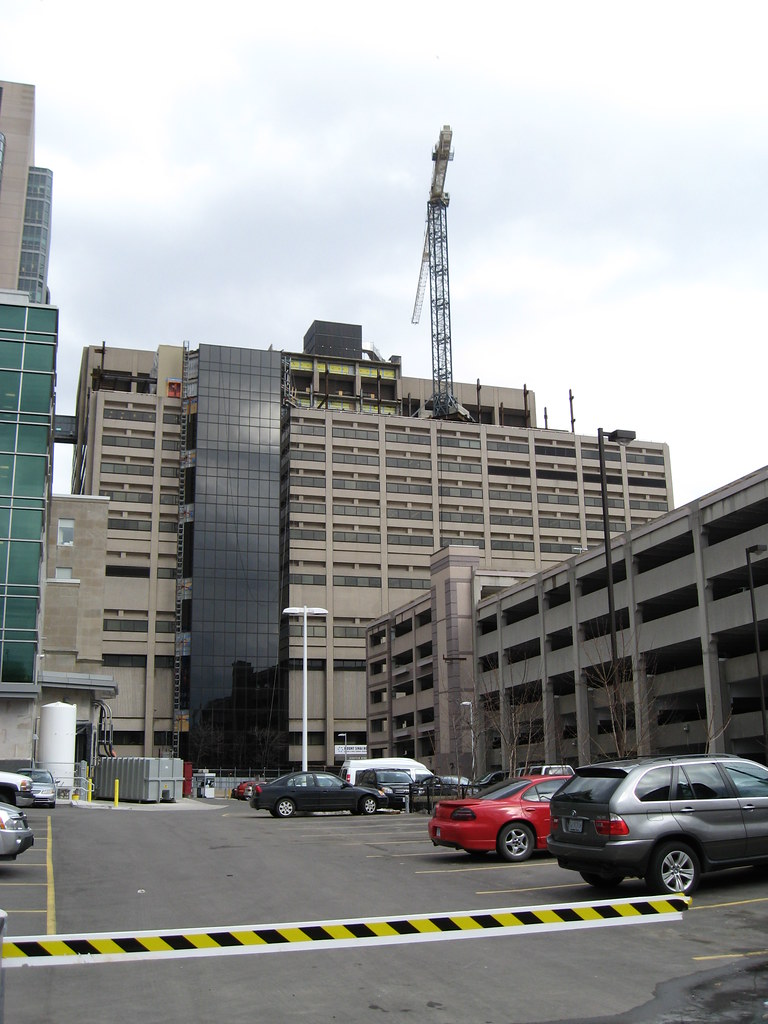from today's Daily Commercial News...
Jan. 17, 2008
Vanbots Construction takes on post-tensioning challenge at Mount Sinai Hospital project
Subcontractor Harris BBR partners on one-of-a-kind project
DON PROCTER
correspondent
Anyone passing by Mount Sinai Hospital in downtown Toronto might notice construction underway on what will be a major transformation: the women’s and infants’ care department built on six new floors atop the existing 14-storey west wing.
What passersby won’t see is almost as significant: a daunting project of structural upgrading.
For starters, the three banks of elevators in the central core of the hospital will go through a major overhaul that involves the installation of two post-tensioned cables at each corner of the elevators.
The work won’t be a piece of cake.
“I don’t think this kind of post-tensioning has ever been done in Toronto before,” says Errol Dubé, senior project manager, Vanbots Construction Corporation, general contractor for the $50 million project that includes the new six-floor addition.
In many cases, seismic reinforcement simply involves the addition of shearwalls or bolting plates to existing shearwalls at elevator shafts. “It stiffens them (elevator core walls) up, but not to the extent of what we’re doing with post-tensioning at Mount Sinai,” Dubé points out.
At the hospital, 25- and 50-foot deep holes eight inches in diameter will be drilled at each corner of the elevator shaft into bedrock for the installation of anchor cables. The cables will be anchored to a grade beam constructed at the shaft’s base slab, explains Tim Pahapill, project engineer of the post-tensioning subcontractor Harris BBR, a joint venture between Canadian BBR Inc. and Harris Rebar.
The grade beam also secures post-tensioned cables rising up the inside of the shaft to the roof, explains Pahapill, noting the cables prestress the shaft concrete vertically. “It’s quite an elaborate mechanism.” The total pre-stressing loads on each corner are 1.87 million pounds, he says.
The project is one of a kind. But the project engineer says a conventional post-tensioning approach wasn’t deemed practical.
Pahapill says how to meet clearance requirements between the elevator and the cables will probably be one of the most challenging elements of the job, largely because the core — like all tall elevator cores — won’t be perfectly plumb. Each cable will be contained inside bracketed sheaths bolted to the inside corner of the shaft walls.
Each elevator bank will be post-tensioned at different times to minimize disruption to hospital operations. “One of our biggest challenges is how to interface with the hospital to avoid interfering with their operations,” explains Pahapill.
Drilling through bedrock will be done from service tunnels underneath the hospital. But because the tunnels are busy service expressways between hospitals in the area, that won’t be an easy feat.
The plan calls for the fabrication of a rock drill to “squeeze into a three-foot space” in the tunnels, leaving at least four feet of clearance for hospital traffic (including equipment pallets) to pass. “It’s tight,” says Pahapill.
Another seismic upgrade involves replacing concrete block walls with reinforced concrete shearwalls at four major stairwells. Eliminating all noise — such as drilling into beams to anchor rebar — will be impossible, but controlled walls (hoarding) will be installed in each floor as a buffer to hospital activities, explains Dube.
But it’s not just noise that contractors have to minimize. New dust control legislation in Ontario also makes the structural project tougher, points out Altaf Stationwala, senior vice-president of Mt. Sinai’s operations and redevelopment.
Stationwala says the decision to go with such extensive structural upgrades was to ensure that the wing meets the 2006 Ontario Building Code (OBC). “Our permit for the fitout is subsequent to the (introduction of the) ’06 OBC so we want to make sure we are compliant.”
The code classifies hospitals as “post-disaster buildings,” meaning they must be able to continue operating when disaster strikes, adds Stationwala.
Installing structural steel for the six additional floors requires a large tower crane located beside the hospital. The crane’s pad will be constructed at grade. It will consist of a 32- by 32-foot poured concrete base five-to-six-feet in depth. Normally, cranes are founded below grade but that isn’t possible because of underground utility services, says Dube.
The project will be completed in the spring of 2009.
It is one of several hospital projects approved under ReNew Ontario, the province’s five-year, $30-billion plan to modernize and replace many of the province’s hospitals, schools and post-secondary institutions. $5 billion is allotted for health care infrastructure.




